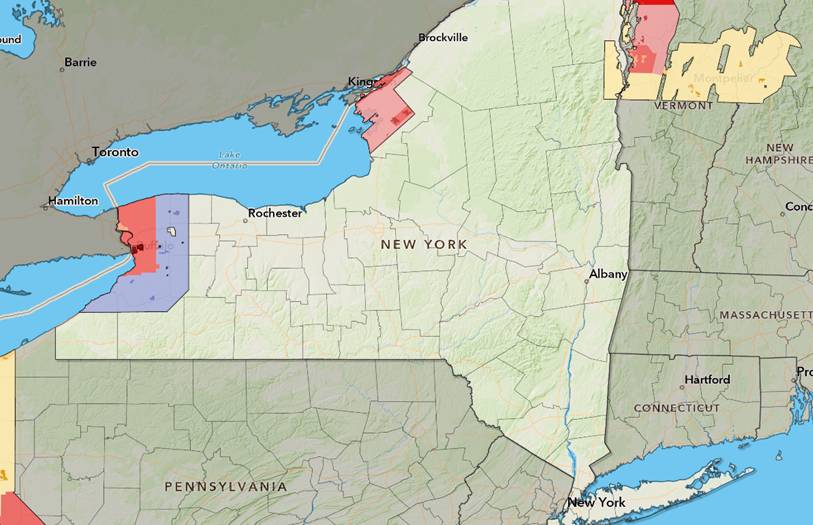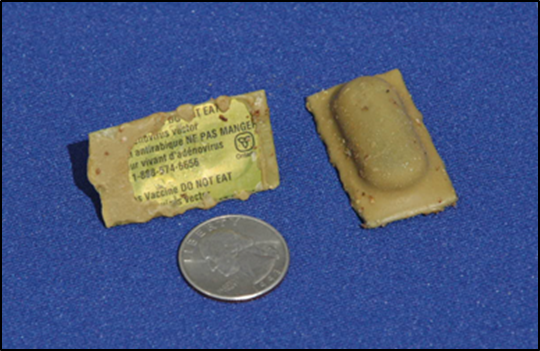NCDOH Takes Part in Effort to Wipe Out Terrestrial Rabies: Oral Rabies Vaccine (ORV) Distribution Project Begins 13th Year
Niagara County and New York State will once again be taking part in a nationally coordinated effort to halt the spread of raccoon rabies in 13 states. Ongoing field assessment of the oral rabies vaccine (ORV) called ONRAB will occur in Clinton and Essex counties in the Empire State as part of a program that also includes parts of northern Vermont and New Hampshire. Additionally, ONRAB ORV baits will be distributed in Erie, Jefferson, Niagara, Oswego, and St. Lawrence counties. These areas were selected in part due to ongoing collaboration with Quebec and Ontario, Canada, in the fight against rabies to protect human and animal health and reduce significant costs associated with living with rabies across broad geographic areas. This spring, RABORAL® V-RG will also be distributed in Cattaraugus, Chautauqua, Erie, Genesee, Niagara, Orleans, and Wyoming counties.
The field trial includes aerial and hand distribution of rabies vaccine-containing baits (ONRAB and RABORAL® V-RG brand). In the Buffalo-Niagara region of western New York, 9,450 ONRAB baits will be distributed using bait stations. Additionally, 23,850 ONRAB baits will be distributed by vehicles, and 186,300 baits by helicopter, both occurring approximately through mid-June (Figure 1).
western New York, 9,450 ONRAB baits will be distributed using bait stations. Additionally, 23,850 ONRAB baits will be distributed by vehicles, and 186,300 baits by helicopter, both occurring approximately through mid-June (Figure 1).
 western New York, 9,450 ONRAB baits will be distributed using bait stations. Additionally, 23,850 ONRAB baits will be distributed by vehicles, and 186,300 baits by helicopter, both occurring approximately through mid-June (Figure 1).
western New York, 9,450 ONRAB baits will be distributed using bait stations. Additionally, 23,850 ONRAB baits will be distributed by vehicles, and 186,300 baits by helicopter, both occurring approximately through mid-June (Figure 1).Raccoons are vaccinated against rabies when they eat the wildlife rabies vaccine that is contained in the baits. “During the baiting period, residents may see and hear low-flying aircraft over Niagara County and may observe local health department staff distributing green packets by hand and car around Niagara Falls neighborhoods,” said Scott Ecker, Environmental Health Director. The ONRAB baits are about the size of a matchbox and are comprised of vegetable shortening, wax, icing sugar, vegetable oil and flavoring. Humans and pets cannot get rabies from the bait. If you find ORV baits, leave them alone, unless they are found where children or pets play. Follow ORV recommendations (see Frequently Asked Questions).
“Rabies is a fatal but preventable viral disease. It can be spread to people and pets through bites or scratches of an infected animal (raccoons, skunks, bats, and other mammals). Rabies primarily affects the central nervous system, leading to severe brain disease and death if medical care is not received before symptoms start. Rabies vaccine is a key tool in preventing spread of the disease.” explained Public Health Director Daniel J. Stapleton, who added, “Keeping your pets up to date on rabies vaccine is not only NYS law but one of the most important things you can do for your pets, yourself and your family to prevent rabies.” The Environmental Division offers free rabies clinics 5 times a year. The next clinic is Saturday, July 12 (9 a.m. - 12 p.m.) Town of Royalton Highway Garage, 5316 Royalton Center Road. Registration is required for our rabies vaccination clinics, and registration opens the first business day of the week of the clinic.
View the complete rabies clinic schedule on our webpage at: www.niagaracounty.gov/rabiesclinic.
Questions related to the ORV ONRAB field trial may be directed to the USDA Wildlife Services at 1-866-487-3297.
Frequently Asked Questions about the Oral Rabies Vaccination Program
USDA Wildlife Services (WS) 2025 ONRAB Field Evaluation
Q. What is the ONRAB ORV Field Evaluation?
A. In spring and summer 2025, Wildlife Services and cooperators will distribute the ONRAB (Artemis Technologies Inc., an indirect, wholly-owned subsidiary of Ceva Sante Animale S.A., Guelph, Ontario, Canada) oral rabies vaccine in 8 states (ME, NH, NY, OH, PA, TN, VT and WV) as part of an ongoing evaluation of its effectiveness in the field. This year’s field evaluation is part of a multi-year study addressing operational questions related to bait density, flight line spacing, and effectiveness.
Q. What does the bait look like?
A. The ORV baits consist of a sachet, or plastic packet, containing the rabies vaccine. To make the baits attractive, the packets are sprinkled with a fishmeal coating or encased inside hard fishmeal–polymer blocks about the size of a matchbox. See Figure 2.
coating or encased inside hard fishmeal–polymer blocks about the size of a matchbox. See Figure 2.
 coating or encased inside hard fishmeal–polymer blocks about the size of a matchbox. See Figure 2.
coating or encased inside hard fishmeal–polymer blocks about the size of a matchbox. See Figure 2.Q. Can I get rabies from contact with the vaccine?
A. No. The vaccine does not contain the live rabies virus; however, it contains a single gene that may cause a local pox-type infection in people who are pregnant or have an immunodeficiency disease. Anyone who comes into contact with the liquid vaccine should wash the affected area thoroughly with soap and water and call the phone number listed on the bait or your local health department for further instructions and referral.
Q. What if I find an oral rabies vaccination (ORV) bait near my home?
A. It is recommended that if bait is found it is not disturbed unless it is on your lawn, driveway, or other area where it is not likely to attract a raccoon or other wild animal. While wearing a glove or other protective covering (i.e., plastic bag), you could move bait to a wooded area where a raccoon, skunk, fox or coyote will be more likely to find it. Wash your hands thoroughly with soap and water after any contact with a bait.
Q. Why do I need to wear a glove when handling an ORV bait?
A. An intact bait will not harm you, but the bait coating may get on your skin. If a blister pack within the bait is broken and the liquid vaccine is visible, use protective gloves or pick the bait up in a plastic bag without making contact with it. Cover the bait with 1:10 dilution of household bleach, and wipe down affected areas with bleach solution. Place cleaning materials in a bag and dispose of the bag in regular garbage. Wash your hands thoroughly with soap and water after contact with bait. If you suspect you have been exposed to the vaccine, please contact Niagara County Department of Health’s Environmental Division at (716) 439-7444.
Q. What if I do not have a glove?
A. You can use a plastic bag or paper towel to prevent you from coming into direct contact with the bait and vaccine. Be sure to dispose of it after use.
Q. What if my child finds an ORV bait?
A. If your child were to bring you an intact bait, you may place the bait into an area of thick cover. If your child brings you a bait that is leaking vaccine, wash the exposed skin and contact your local public health officials for further instructions and potential referral. Wash your hands thoroughly with soap and water after contact with a bait.
Q. What if my dog or cat eats an ORV bait?
A. This vaccine has been shown to be safe in over 60 different species of animals, including domestic dogs and cats. Eating a large number of baits may cause a temporarily upset stomach in your pet, but it does not pose a long-term health risk. Do not attempt to remove a bait from your pet’s mouth; doing so may cause you to be bitten and could lead to vaccine exposure. If your pet becomes ill from bait consumption, please contact your veterinarian for more information.
Q. How long do ORV baits last in the environment?
A. Studies have shown that most baits are eaten within 4 days, and almost all baits are gone in 1 week. If baits are not found and eaten, they will dissolve and expose the vaccine. Sunlight and exposure to air inactivates the vaccine.
Q. How does a raccoon get vaccinated by eating the ORV bait?
A. When a raccoon bites into a bait, the vaccine packet is punctured allowing the vaccine into the animal’s mouth. The raccoon’s immune system is then tricked into thinking it has been exposed to the rabies virus and makes antibodies to fight the disease. The blueprint on how to make these antibodies is stored in the raccoon’s immune system, allowing its body to respond should it be exposed to a rabid animal.
Q. How long does the vaccine last?
A. Research suggests this vaccine should be effective for more than a year; however, it is difficult to determine how immune systems in individual animals will respond to the vaccine.
Q. How do you distribute ORV baits in cities and suburban areas?
A. Working with employees from cooperating agencies, WS distributes baits in urban and suburban areas by vehicle or by helicopter. These are the most effective approaches for distributing the bait and minimizing human contact with baits.
Q. How else does WS distribute ORV baits?
A. In rural or open areas, WS distributes baits using aircraft. Depending on the distribution area and availability of aircraft, a helicopter or fixed wing aircraft may be used.
Q. How can I find out more information about this program?
A. If you have additional questions related to the field evaluation in New York, please contact the Wildlife Services office in Rensselaer, NY at (518) 268-2289.
